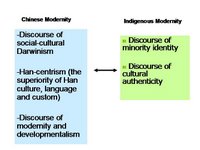1. Anthropology in the post-colonial age
1.1. Modern anthropology is a reflection upon social Darwinism.
1.2. Social Darwinism is a school of thought emerging out of colonialism
1.3. Modern anthropology (e.g. Malinowski, Mead and Levi-Strauss) attempts to provide an alternative way of seeing “others” to the prejudices of social Darwinism.
1.4. Anthropologists adjust their mission and problematic to respond to the new age of post-colonialism.
1.4.1. Modernization and colonization do not create a unified modern world.
1.4.2. Anthropology in a multi-cultural setting
Kahn, Joel. 1995. “A World System of Culture?” Culture, Multiculture, Postculture. London: Sage.
2. Anthropology in a multi-cultural setting
2.1. Cities: a meeting place for a wide range of ethnic groups.
2.2. Indigenous people defend their rights and identities against the corporate and the state power.
2.3. Critique of functionalism
- Not every pattern of behavior or relation has functions necessary to the survival of individual and the society.
Example: Festival and other rituals in the modern society
2.4. Critique of structuralism and rationalism
-Deep structure is only a kind of academic fiction without material and historical complexity (Clifford Geertz).
2.5. Example I: Japanese food
-How do we explain why Japanese people hadn’t eaten salmon fish as sashimi until after the Second World War?
-How did salmon fish come into Japanese diet?
-What is the (symbolic) association between salmon fish and Japanese traditional diet?

3. Interpretive anthropology:
Clifford Geertz (1923-)
“What the ethnographer is in fact faced with … … is a multiplicity or complex conceptual structures… …”
3.1. Example: Twitch, wink, parody and rehearsal?
The meaning of a facial expression or gesture is determined by our interpretations of multilayers of signification.
3.2. Seeing culture as a text
“Doing ethnography is like trying to read (in the sense of “construct a reading of”) a manuscript – foreign, faded, full of ellipses, incoherencies, suspicious emendations, and tendentious commentaries, but written not in conventionalized graphs of sound but in transient examples of shaped behaviour.”
4. Culture and interpretation
4.1. Culture is public.
4.2. Public is subject to multiple interpretations
4.3. Interpretation is a symbolic process.
5. Thick description
5.1. We begin with our own interpretations of:
5.2. What our informants are up to,
5.3. What they think they are up to.
5.4. And then we systematize those.

Example I: Balinese birth-order names and “dramatism”
Birth-order names.
Individual: an assigned role in hierarchy.
Balinese society and designation are highly ritualized.
The world is an eternal cycle, an endless four-stage replication of an imperishable form.

Example II: When Coke becomes a national beverage, … …
Coke=Home
Home=Nation
Coke=National culture
pic 1 and
pic 2"I fight as much to help keep the custom of drinking Cokes as I am to help preserve the millions of other benefits our country blesses its citizens with."
A letter written by a US soldier to his family.
Mintz, Sidney W. 1996. "Food and its relation to power."
Tasting Food, Tasting Freedom: Excursions into Eating, Culture and the Past. Boston: Beacon Press.
6. What is anthropology (according to Geertz)?
6.1. Ethnography is a study in a place rather than of a place.
6.2. Ethnography is a series of interpretation of social discourse.
6.3. “Cultural analysis is (or should be) guessing at meanings, assessing the guesses, and drawing explanatory conclusions from the better guesses, not discovering the Continent of Meaning and mapping out its bodiless landscape.”
7. The object of analysis: Social discourse
7.1. Regularities within communication.
7.2. They could be identified in the everyday life.
8. Ethnography is … …
8.1. Ethnography is a fiction of material complexity.
8.2. Ethnography is never complete and its authority is always contestable.
8.3. The aim of anthropology: Enlargement of the universe of human discourse
8.4. Cultural analysis<---->natural science
Appendix: Interpretive anthropology vs. structuralist anthropology


Structuralist anthropology-“Bodiless landscape”

Symbolic or interpretive anthropology-Social discourses Symbolic regularities in -communication

Enlargement of the universe of human discourse















